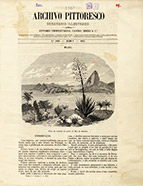

................................
The frequent comparison with O Panorama , which emerged two decades earlier, is no coincidence. Many of the authors contributing to AP were also associated with O Panorama . Moreover, as AP was recognised for its literary merit and the dedication of Portuguese intellectuals of the time, it continued in the spirit of the new ideas and opportunities sparked by the liberal revolution— an impulse that O Panorama had earlier embodied, despite setbacks due to censorship imposed on the Portuguese press. Broadly speaking, such restrictions affected the 1820s and 1830s until the passing of the Press Law in 1834, which coincided with the end of absolutism. Understanding the political backdrop that spurred the rise of literary journals sheds light on the editorial character of AP. Unlike opinion journalism, publications like AP and O Panorama focused more on the spread of knowledge and educational content. Notably, O Panorama emerged as part of a civic organisation known as the Sociedade Propagadora de Conhecimentos Úteis [Society for the Propagation of Useful Knowledge]. In the early 19th century, external influences— such as the French invasions and the ideas brought back by returning Portuguese exiles (especially from England and France) after 1820— were pivotal in shaping the press. Figures like Herculano and Almeida Garrett epitomised this trend. However, beginning in the late 1830s, significant reforms allowed a more centralised state to engage with intellectuals who wished to influence the emerging social model. This trend is evident in the pages of AP.
AP’s editorial mission, outlined in its first prologue as a “Portuguese newspaper for Portuguese people” ( AP , 1857, p. 1), reflected a keen interest in the colonies in Africa and Asia and, especially, in Brazil. Here, language served as a unifying tool, but it was far from the only resource available for fostering this connection. The inaugural issue of AP opened with an engraving of the entrance to the port of Rio de Janeiro, setting the tone for the publication’s core aims. Like O Panorama , AP made a strong commitment to visual content, establishing illustrations as a defining feature of the weekly. While not pioneers in integrating images into this genre, these periodicals gave visual elements a significant role throughout AP's entire collection, particularly through wood engravings, which were widely utilised. These engravings featured prominently in nearly every main section, not merely as decorative elements but as complementary or even introductory tools to the written content. For example, the first issue included a biographical article on Alexandre Herculano, accompanied by an engraving of the biographer himself. The “travel memories” section, a recurring feature over the years, often showcased images of cities described by the authors. In the twelfth issue of AP, Andrade-Ferreira commented in his article, Jornalismo literário em Portugal [Literary Journalism in Portugal], that “it is these newspapers that Portugal most needs, because in this way, without intimidating the popular mind, it is both possible and pleasant to guide readers to the sources of our history and to the most basic notions of the moral sciences, making accessible and appealing what had been previously inaccessible in diffuse compendiums” ( AP , 1857, p. 93).
This work is financed by national funds through FCT - Foundation for Science and Technology, I.P, in the scope of the projects UIDB/04311/2020 and UIDP/04311/2020.
